
Piece in solid wood incorporating oil paintings and polychrome wood sculptures. Circa 1500-1510
What is an altarpiece?
An altarpiece is a religious work of art which serves as a backdrop for an altar; in other words, it is positioned behind the consecrated table on which Mass is celebrated. From the 15th to the mid-16th century, Brussels was famous for its production of altarpieces in carved wood with painted panels, which it exported throughout Europe.
A prestigious order
This altarpiece was produced at the request of an aristocratic family from Northern Italy, who first had it installed in Mondovi, then in Saluzzo - hence the name “Saluzzo Altarpiece”, by which it has since been known. When it was resold on the art market at the end of the 19th century, the City of Brussels acquired it.
Displayed in two sections
Although it used to form a single whole, the altarpiece is presented in the museum in two separate sections.
 On one side of the room is the wooden box enclosing carved, painted and gilded scenes. This comprises a central section and a box on either side connected by a hinge, which could be closed.
On one side of the room is the wooden box enclosing carved, painted and gilded scenes. This comprises a central section and a box on either side connected by a hinge, which could be closed.
Both had a wood panel painting on the back. To enable visitors to admire them, these two painted panels have been dismantled, placed in a new frame and are now displayed on the other side of the room.
An exceptional double pair of panels
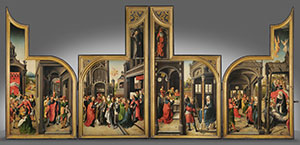 You will see that there are two painted “flaps” on the sides of these two panels, attached by a hinge.
You will see that there are two painted “flaps” on the sides of these two panels, attached by a hinge.
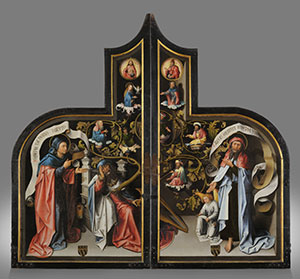 These could also be closed to reveal the back. Take a look; mirrors have been provided to make it easier to see the elaborate composition featuring the Tree of Jesse, which traces the genealogy of the Virgin Mary and her husband Joseph back to King David.. This was the view of the altarpiece that was displayed most of the time, when it was completely shut.
These could also be closed to reveal the back. Take a look; mirrors have been provided to make it easier to see the elaborate composition featuring the Tree of Jesse, which traces the genealogy of the Virgin Mary and her husband Joseph back to King David.. This was the view of the altarpiece that was displayed most of the time, when it was completely shut.
A rite of passage
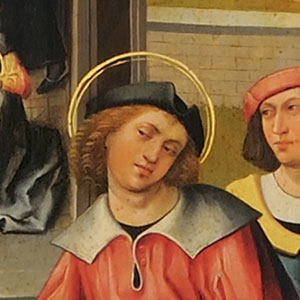 During ordinary religious ceremonies, the “flaps” were first opened to reveal the four painted panels recounting the story of Joseph, which reads from left to right. The saint can be easily identified by his aura. Told through scenes which the artist places in a contemporary setting, the story of Joseph’s life is depicted from his birth through to his burial.
During ordinary religious ceremonies, the “flaps” were first opened to reveal the four painted panels recounting the story of Joseph, which reads from left to right. The saint can be easily identified by his aura. Told through scenes which the artist places in a contemporary setting, the story of Joseph’s life is depicted from his birth through to his burial.
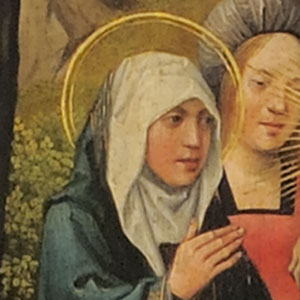 The paintings are probably the work of Valentin Van Orley, who discreetly incorporated the inscription ORLEI in the border of the cloak of the Madonna which appears in the final scene.
The paintings are probably the work of Valentin Van Orley, who discreetly incorporated the inscription ORLEI in the border of the cloak of the Madonna which appears in the final scene.
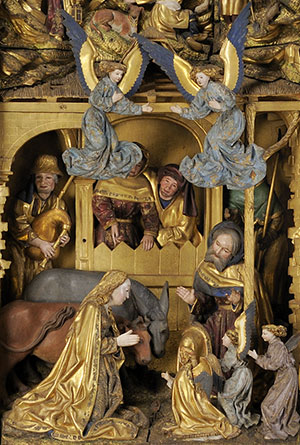 It was only on special occasions, during the most important festivals in the Christian church (Easter, Christmas, Whitsun) that the altarpiece was opened up entirely to reveal its interior. In a flamboyant gothic setting, the carved episodes tell the story of Mary, centering around the birth of Christ. The colours impart a vividness to the scenes whilst the lustre of the gold alludes to the divine presence.
It was only on special occasions, during the most important festivals in the Christian church (Easter, Christmas, Whitsun) that the altarpiece was opened up entirely to reveal its interior. In a flamboyant gothic setting, the carved episodes tell the story of Mary, centering around the birth of Christ. The colours impart a vividness to the scenes whilst the lustre of the gold alludes to the divine presence.
A tremendous feat of construction
The exquisitely carved scenes were probably created in one of the ateliers of the Borreman family, who were very well-known for producing these types of works in Brussels. Once they had been painted and gilded, they were flawlessly assembled in the wooden box.
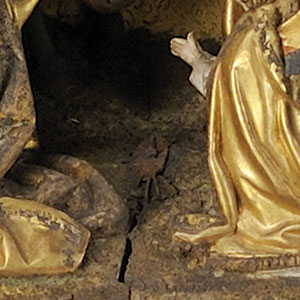 In the nativity scene, you will note the absence of the infant Jesus who, sadly, was stolen. However, this loss does allow us to see the type of attachment that used to hold the small, carved piece that has now disappeared.
In the nativity scene, you will note the absence of the infant Jesus who, sadly, was stolen. However, this loss does allow us to see the type of attachment that used to hold the small, carved piece that has now disappeared.
A complete work of art
The Saluzzo Altarpiece is a masterpiece of its genre. It is the fruit of a close collaboration between the various artists and artisans involved: carpenters, cabinetmakers, wood carvers, painters, polychrome artists and gilders. All were subject to the inspections carried out by their corporation. Some were also inspected by the urban authorities.
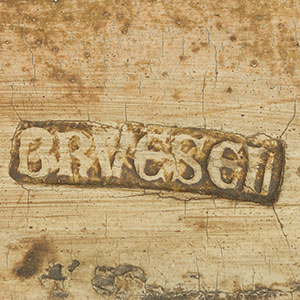 The “Bruesel” hallmarks which can be seen at the bottom of the altarpiece attest to the quality of the polychrome work and the gilding.
The “Bruesel” hallmarks which can be seen at the bottom of the altarpiece attest to the quality of the polychrome work and the gilding.
Next step
Go upstairs to the first floor, but don't forget to admire the grand staircase and the neo-Gothic stained glass windows. When you reach the top, we invite you to watch the short film on Brussels' urban development.
Then, enter the large room to look at the scale model of Brussels in the 13th century. Now head to the oldest maps displayed in this room.




